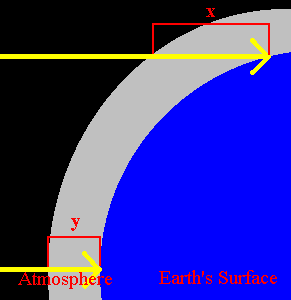Seasonal Temperatures
Now, you may have noticed that the winter temperatures are colder than
the summer temperatures, and perhaps you have even wondered why this
is. Well, there are a few reasons, and this last lesson will briefly
explain what those reasons are, and why they interact with our
temperatures here on the surface.
First, you must consider that the sunlight in the winter is spread out
over a larger area, and second, the sunlight also passes through
the atmosphere at a lower angle which makes it pass through a thicker
amount of atmosphere. Remember: Sunlight is energy, and energy is heat, so
the heat that a location receives is directly related to the amount of energy
that reaches the Earth's surface. Here, you will see these concepts illustrated
in depth.
Light Spread (NOT butter...!)
The analogy often used to describe this phenomena has to do with a
flashlight being shined at a wall. If you shine it straight at the
wall, you get a shape like Figure 1, below. If you shine it at an
angle, though, say with the flashlight pointed partially toward the
ceiling, you would get a spread-out shape like Figure 2 shows.


Now, consider this:
- The flashlight puts out the same amount of energy whether it is
tipped to the ceiling or pointed straight at the wall.
- The area of the shape illustrated in Figure 2 is larger than that
of Figure 1.
- Therefore, we can conclude:
- the larger shape is receiving less energy per square
inch than the smaller one is.
- the smaller shape is getting more concentrated
energy than the larger one.
Still don't get it? That's all right. Think of it this way. Energy
per square inch is, if E is energy and A is area,
E / A
If the area of the circle in Figure 1 is 4 square inches, and the area
of Figure 2 is 7 square inches, and if the flashlight puts out 28
Watts, it becomes
(28 Watts) / (4 Square Inches)
for Figure 1, and
(28 Watts) / (7 Square Inches)
for Figure 2. You can see that the answer for Figure 1 is 7 Watts
per Square Inch, and only 4 Watts per Square Inch for figure
2, proving that Figure 1 gets more energy per square inch than
Figure 2.
This same thing happens on Earth, to a far bigger extent. Think of
the Sun as a giant flashlight shooting out single beams toward Earth.
I know it seems a little silly, but the concept is still the same.
See?

Atmospheric Scattering
As the sun passes through the atmosphere, there are little particles of gas and
even dust that will scatter light, much like the sunbeams that can be seen in a
room that has just been dusted. At the equator, the sun, mainly, passes through
little atmosphere, and is therefore subjected to less scattering. On the other
hand, however, the light reaching the poles passes through up to 45 atmospheres'
worth of air!
 If we look again at single beams hitting the earth at the equator and poles,
you can see that x, the depth of atmosphere through which the
light must travel near the pole, is much greater than y, the
depth of atmosphere through which sunlight passes near the equator.
If we look again at single beams hitting the earth at the equator and poles,
you can see that x, the depth of atmosphere through which the
light must travel near the pole, is much greater than y, the
depth of atmosphere through which sunlight passes near the equator.
Add them together...
- Take the North Pole to be approaching winter (only a few hours of
light per day).
- Add the effects of the light spreading, getting a minimal amount of energy
in any given area.
- Throw in the effects of atmospheric scattering, thereby reducing the amount
of light that spreads when it reaches the surface.
- You get a pretty chilly place!
***
- Point the Equator at the sun (solstice).
- The light spreads little, and a maximum amount of energy occurs in any
given area.
- Only passing through the depth of one atmosphere allows little scattering.
- Tropical warmth dominates the area!
And there... you have it!





